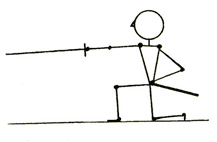
This section is edited by the 20th Master Shibata Hyakuren. It is based on a lecture given by the 18th Master Hokiyama at a seminar in Osaka (Dai Nippon Butoku-kai Osaka Branch) This seminar was held annually between 1927 and 1934
1, It is most essential and important that beginners perform large and slow movements. In reaching a higher level, it is possible to shorten the Ma.
Addition : An important point of Nuki-waza (Nukitsuke etc.) is that the Kissaki reaches out to the target (opponent). Consequently the drawing motion must be taken as the Kissaki is aimed at the target. Musashi says in Gorin-no-Sho, Stretch the elbow and swing the sword strongly. As the speed of the action get faster, ability and quality improve. At no time did Oh-e Sensei ever do a fast, showy performance.
2, In execution of all forms, The Kissaki does not stop as it separates from the Koikuchi.
Addition : Separation is this case means the distance between Kissaki and Koikuchi when taking Nukitsuke action. The sword must be smoothly drawn forward before cutting.
3, Nukitsuke (all forms). The upper body must be held upright. In other words Do not lean forward. Addition : The waist and abdomen should be positioned firmly. Loosen the shoulders when doing Nukitsuke.
4, Nukitsuke action straight towards the front is one of the fundamental movements. There should not be too wider distance between the front foot and the back knee to maintain upper body balance.
 |
Addition: This means; a, The angle of the front leg (behind the knee) is less than 90 degrees b,The back knee is positioned behind the body-line to keep the posture upright. In addition, if the front foot is spaced too far away, the back foot and knee would be left behind and might slip away pushing the body forward. |
5, In the case of Furikaburi action after Nukitsuke, the right fist must be brought directly above the head without passing over the left shoulder. In other words, the Kissaki, not the fist is brought over the left shoulder.
Addition : From Nukitsuke the right wrist is twisted to the left. As a result of this the Kissaki passes under the left ear with a thrusting movement. At this moment the left hand seizes the Tsuka to take Jodan-no-Kamae, (the Tsuba is almost hidden behind the head).
6, When bringing the back foot to meet the front foot (Shomen Nukitsuke, Chiburui) The upper body must incline forward.
Addition : This leaning forward posture is inhibited in almost every ryu of Iaido. The hips are slightly dropped with the knees slightly parted. At this point one must be prepared to take the next move using the hips and waist.
7, Metsuke (Eye Contemplation/Gaze) is of the essence not only in facing an opponent but also in individual practice.
Addition : In Iaido the targeting and power of Metsuke is significant. In Kendo is Ichi-gan (first and foremost looking at the opponents eyes). However in Iaido, Metsuke must be used to comprehensively observe the opponents body. Its degree has to be wider than the Metsuke in Kendo. The authoritative power of Metsuke is also significant. I was overwhelmed when I met Master Ueshiba Morihei in 1941. He displayed to us the power of Metsuke.
8] Throughout all the forms the position of both hands in Kirioroshi action should not be too high. If so the left hand will be in Shini-te (dead hand). Addition : This is a caution about gripping with the hands at the end of Kirioroshi. When both hands have ended up too high the elbows will be too constricted and the wrists inert.
![]() Both arms are to be comfortably
straight.
Both arms are to be comfortably
straight.
![]() In avoiding Shini-te, the
left hand must not be higher than the right.
In avoiding Shini-te, the
left hand must not be higher than the right.
| Next page |